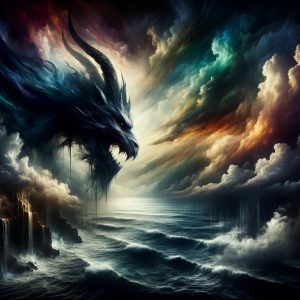“The Identity of the Beast in Biblical Prophecy: A Deep Dive into Revelation and End Times.”


The Beast is an enigmatic figure that appears predominantly in the book of Revelation, leaving believers and scholars alike puzzling over its identity. The Scriptures offer various signs, symbols, and descriptions, aiming to provide clues, yet the identity remains shrouded in mystery.
Revelation 13:1-2 introduces us to the Beast, describing it as rising out of the sea with “seven heads and ten horns,” adorned with crowns and blasphemous names. This imagery is laden with meaning, as waters often symbolize masses of people or nations (Revelation 17:15), and horns and heads represent power and authority. Scholars have debated whether the Beast is an individual, a political system, or an amalgamation of both.
Continuing in Revelation, chapter 17 gives us more detail. The Beast is described as an entity that “was, and is not, and yet is.” This has been interpreted as a system or individual that has historical roots, undergoes a period of absence, and then re-emerges powerfully in the end times. This is interesting to note, especially when we consider the events unfolding in the world today, from the wars prophesied in Ezekiel 38-39 to the unsettling actions of groups like Hamas.
The apocalyptic scenario gets darker as the book of Revelation unfolds. The Beast is endowed with power from the Dragon, identified as Satan in Revelation 12:9, to deceive the nations and enforce a system of worship (Revelation 13:4-8). This is further corroborated in 2 Thessalonians 2:9-12, where Paul talks about a “man of lawlessness” who comes with deceitful miracles, empowered by Satan.
As tensions escalate globally and we witness heart-wrenching events, it’s easy to ponder how much worse things can get. Scripture provides guidance here as well. In Ephesians 6:12, Paul tells us that our true battle is not against flesh and blood, but against spiritual forces of evil. This is a somber reminder that the events we witness are part of a larger cosmic conflict.
The Bible also cautions that the last days will be akin to the “days of Noah,” characterized by widespread wickedness and divine judgment (Matthew 24:37-39). In the days of Noah, human thoughts were continually evil, which led to the flood as a form of divine judgment (Genesis 6:5-7). Similarly, the rise of the Beast and the tribulations that follow can be seen as a form of judgment, reminding us of the gravity of these times.
So, what can believers do? It’s crucial to maintain a close relationship with Yeshua, staying grounded in Scripture, prayer, and fellowship, in order to discern the signs of the times and to prepare spiritually for what’s ahead. Just as the disciples witnessed Yeshua’s transfiguration and heard the voice of Yehovah affirming His Son (Matthew 17:1-9), so too must we listen to the divine guidance provided in God’s Word.
In summary, while the identity of the Beast remains a topic of great debate, what’s clear is that it will play a significant role in the end times, leading people astray and bringing about much suffering. Whether it’s an individual, a system, or a combination of both, its rise will be a significant indicator that the end is near, urging us all to be vigilant and strong in our faith.

